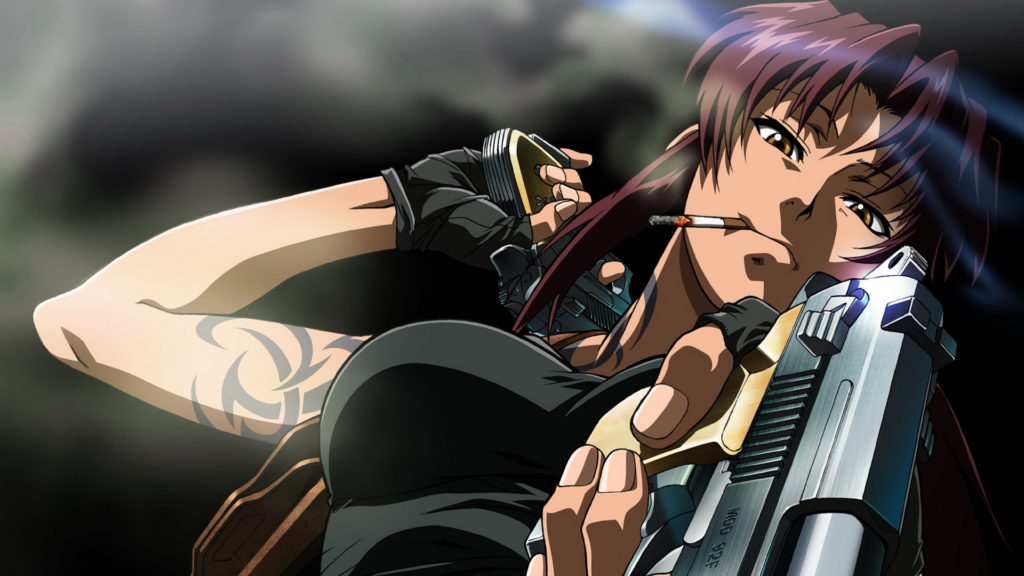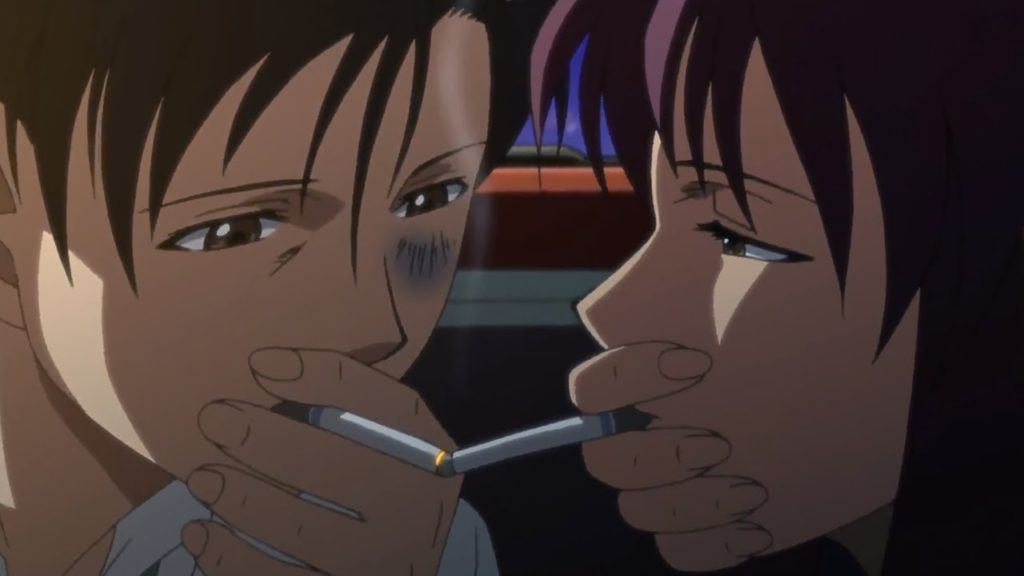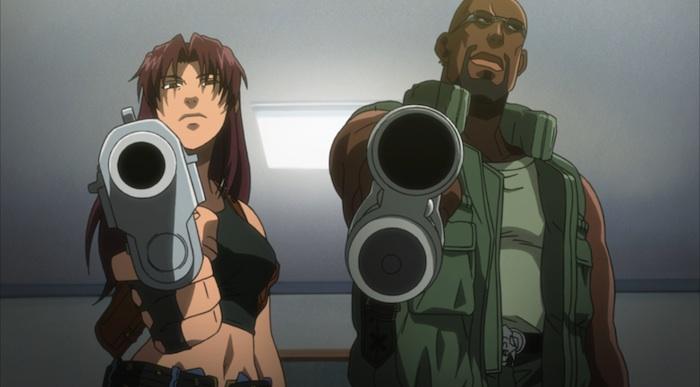Black Lagoon
September 21, 2021 · 0 comments
By Andrew Osmond.

Choose life. Choose a Japanese office job. Choose a neat tie, a pressed white shirt. Choose a daily oblivion of getting on the train, getting to the desk, writing mind-numbing spirit-crushing meaningless reports between brown-nosing your boss. Only in Black Lagoon, anonymous salaryman Rokuro Okajima chooses not to choose life, as we mundane folk would recognise it. Instead, he chooses a lawless city that draws the detritus from real-world hells: stateless soldiers, Mafia gangs, hoodlums, chancers, and the kind of monsters who’d eat your liver with a fine chianti, and hold the fava beans. Black Lagoon is an anime hard-boiled enough to crack your skull.
There’s no paranormal-SF baggage here; no big robots or big-haired shinigami death-gods. Instead, the “Lagoon” team is a group of mercs who will deal with any devil, ferrying whatever goods or people will pay their fees in their torpedo-armed boat, the Black Lagoon. Before Rokuro (“Call me Rock”) joins them, it’s a team of three. Benny is an ex-college kid turned hacker. The Afro-American Dutch has the brains and brawn to be the outfit’s unchallenged leader. But the warped star turn is Revy, who has the kind of curvy looks and skin-exposing outfits that would tempt a certain kind of man into greeting her as babe… and being handed back his brains. Revy likes to kill, a lot, and when she’s got her two guns in her hands and the bloodlust kicks in, you can’t keep count of the corpses.
For his part, Rock gets into the story in the most gormless way, when he’s kidnapped by the Lagoon gang for a company computer disc he’s holding. We cut into the story just as he’s being smacked in the face. At first Rock is a quivering cowardly custard, but when he learns his company has cut him loose to die, his rage helps him grow a pair. He proves his worth by coming up with an escape plan that’s nuts even by the Lagoon’s standards, and then elects to tag along with them rather than return to Japan. In particular, Rock is foolishly taken with Revy and tries to find out what makes her tick, which is not a good idea…

Rather than Japan, the action takes place in Thailand, in and around the imaginary city of Roanapur. New arrivals are greeted by a rope noose dangling from the bridge into town, while everyone ignores the weathered Buddha statue staring out to sea. The characters are a melting-pot: Benny, for instance, is Jewish-American, and Black Lagoon’s top clients are Hotel Moscow, a band of highly-professional Russian soldiers-turned-gangsters led by the scarfaced matriarch Balalakia (and don’t call her “Fryface”). There’s also a Taiwanese dragon-lady assassin, who’s one of Revy’s personal rivals, and two terrifying “vampire” kids from Romania, whom we’ll talk about later.
The original manga was written and drawn by Rei Hiroe, his best-known work in a career crossing professional and “fan” comics (also known as doujinshi). Eleven volumes of the manga have been published in English so far, published by Viz Media. The anime series is made by one of Japan’s top anime studios, Madhouse, famed for its outrageous blends of action and violence since the days of Wicked City and Ninja Scroll.
The director of the Black Lagoon anime is Sunao Katabuchi who would, rather amazingly, go on to the delicate period drama of Mai Mai Miracle, also made by Madhouse,and In This Corner of the World. Katabuchi had already worked on family fare, being the assistant director on Miyazaki’s Kiki’s Delivery Service seventeen years before Black Lagoon. Katabuchi had also made the sweet 2001 film Princess Arete, whose surprising backstory is told here.

Viewed more as a Madhouse anime, Black Lagoon recalls a couple of other properties adapted by the studio. The team-up between the wimpish male Rock and the beautiful Revy has the same role-reversal as the fantasy series Claymore, broadcast a year after Black Lagoon. In it, a caring young boy knocks along with a deadly woman knight in armour. Meanwhile, Rock’s tasting of sheer amorality has overtones of Death Note, in which fans were encouraged to identify with a hubristic schoolboy mass-murderer. One of Black Lagoon’s most startling moments is where Rock, who we’ve thought of as a nice guy, learns the team’s next job is to transport a scared little boy – and Rock simply goes along with it.
Despite these echoes, many reviewers have seen Black Lagoon as a pre-planned bid to make an international anime designed for foreign audiences, perhaps even more than for Japanese viewers. Revy’s two-handed gunplay feels aimed straight at the audience who grew up with John Woo. The set up recalls the work of Tarantino and Rodiguez – Roanapur in Black Lagoon could be Sin City with sun and tropical waters, especially with creations like a gunrunning Catholic “Church” that comes with a psycho nun and Mother Superior. At the same time, it’s part of a tradition of hardboiled manga and anime that goes back forty years, to when a cultural icon crossed from West to East.
We’re talking about James Bond, who tapped into the same bored-male fantasies as Black Lagoon – sun, sea, sex and lots of violence.Bond of course visited Japan in 1967, in the hugely popular Sean Connery film You Only Live Twice. The actor himself hated the experience – he was hounded by fans – but it helped kick-start two very long-lived franchises. One was Lupin III, whose femme fatale Fujiko has shades of Revy, even if Lupin is obsessed with Fujiko’s bosom while the Black Lagoon artists zoom in on Revy’s derriere. But Black Lagoon’s hardboiled amorality owes more to Golgo 13, about an ethnically ambiguous merc killer created by Takao Saito, who’s lasted just as long.
Yet if Black Lagoon is a male fantasy, then it’s one where the ‘manliest’ men like Lagoon’s Dutch are petite second fiddles beside the women. As well as Revy, there’s Roberta, who wears a maid outfit and actually is a maid, though of course she has a colourful and frightening backstory. She’s a Terminator with frills; the artists have fun with her replicating many of the killer robots’ moves as she chases the Lagoon team, who’ve made the mistake of imprisoning her beloved young master. Her storyline lasts three episodes, and ends up with an outrageously bloody punch-up between her and Ravy. It half resembles Kill Bill’s cat-fight between Uma Thurman and Daryl Hannah, and half the cartoon violence of Asterix the Gaul.
But it’s lightweight compared to the series’ most shocking story, the “little vampires” tale. The vampires are young children, a devoted brother and sister with a flair for mass murder, torture and dismemberment. This isn’t the first time Madhouse has entered such queasy territory – the studio made Gunslinger Girl, about kids turned into bionic killing machines – but Black Lagoon takes the scenario to its ghastly conclusion. The child-sibling killers eerily foreshadow the boy and girl who’d revolutionise vampires in Let The Right One In; and you’re left to wonder how their episodes were ever rated ‘15’ uncut by the BBFC.
Andrew Osmond is the author of 100 Animated Feature Films. Black Lagoon is released in the UK by Anime Limited.
Leave a Reply